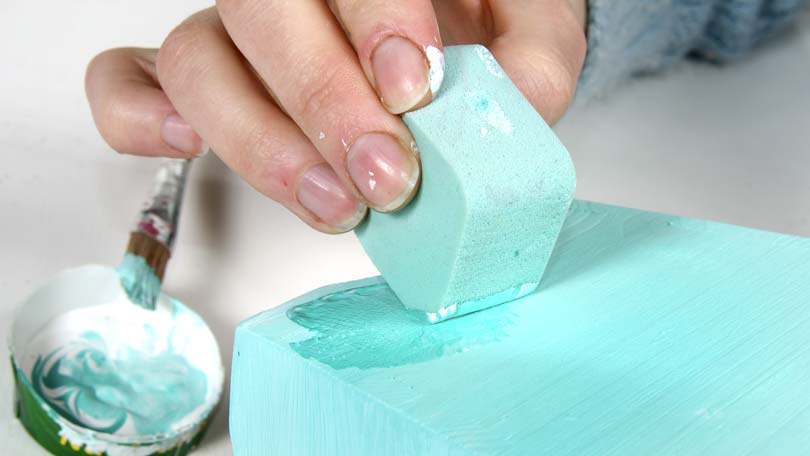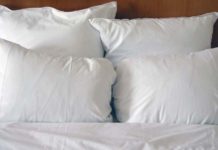
There are many different ways that you can use paint techniques to improve the look of a bedroom. Sponging is one of the simplest techniques of all, but unless you have done it before, if you are intending to be sponge painting a bedroom, it really will pay you to experiment first
While sponging is often used on walls (including bedroom walls), it is also a good technique to use on furniture and woodwork. The technique probably owes its origins to folk art, which is why it is such a popular technique with amateurs (simply, it’s easy). But the beauty of it is that you can achieve a variety of lovely effects that range from a soft, subtle finish to one that is gorgeously crisp and colorful. However you DO have to worry about technique, because badly done, sponging will look (quite simply) horrible!
The best advice is that you need to avoid creating an impression of ugly spots of paint that have been dabbed onto the surface. If you have ever seen a really bad sponge painting job, you will know that it can look really ugly, and at its worst, it can be enough to put any self-respecting person off the technique. But sponging can also look gorgeous, so do give it a try.
The technique has several variations. For instance, you can sponge on, or you can sponge off, depending on the final effect that you want. You can also use one or more colors, gradually building up the effect.
Whichever specific variation of the technique you use, it is vital that the surface you are going to sponge is clean and sound. Even though sponge painting relies on a broken color effect, the background should be solid. So don’t ever forget this. Another good piece of advice is that while contrasting colors can work, generally the best effects you will get are when you use similar tones that actually don’t contrast too much. And if you don’t like the effect you have created, sponging over it with the base color often sorts out the problems. Also, the safest base color is white or an off-white stony hue. But that’s got a lot to do with personal choice.
Suitable paint needed for sponge painting a bedroom
While many of the established paint techniques call for special glazes to make them work, sponging can be done with plain, ordinary emulsion acrylic paints. But you will need to use a sensitive hand to avoid making blotches.
You can also use enamel paints, although natural effects are a little more difficult to achieve unless you mix the paint with proprietary glazes and turpentine. If you decide to use an enamel-type paint, choose an eggshell enamel which is not too shiny, and dilute it a little with mineral turpentine, even if you don’t use a glaze. High gloss is not a choice for sponge painting.
Another less usual option is to use a paint base that has not yet been tinted and to then use a tinter (which is like a specially made paint dye) to make your own very special color. This is the type of paint that they use to give you the color you choose when you have paint custom-mixed in a hardware store or paint store. If you use a transparent base with a tinter, you can achieve some really interesting results, but you will need to experiment. If this idea takes your fancy, buy a single liter can of base paint and experiment either on a properly primed and painted board, or on a wall that you can strip down later and restore to whatever it should look like. Only mix a very small amount of the base with a tiny bit of tinter, otherwise you will waste both base and tinters.
Preparing for sponge painting
Whether you are planning to sponge a wall, a piece of furniture or any other item, it is essential that you prepare the base correctly. It isn’t difficult to do, but if not properly done, you aren’t likely to get good quality results. Always remember that sponging relies on broken color for its success and so you need a good, sound and solid base beneath the sponging for it to work. Don’t ever be tempted to use the technique to hide imperfections in the first layer, and never work on a dirty surface.
Most people prefer to match whatever type of paint they are going to sponge with, with the base coat. So for example, a person sponging onto an acrylic surface, would first paint the wall with a same-type acrylic. But you can defy the rules and sponge an oil-based glaze onto a flat acrylic base. The effect can be rather lovely.
The other aspect of preparation is to make sure you have the right tools to do the job. In addition to normal paint tools – for both preparation and painting – you are going to need a good quality sponge. If you’re serious about sponge painting a bedroom and getting good results, then you will need a real sea sponge. While natural sponges found in the sea are relatively expensive, you won’t get close to a professional finish if you try and do the technique with an acrylic sponge. Ideally look for a nice, big sponge with a lot of variations in terms of the size and shape of holes. You can then turn the sponge as you work, altering the effect. You will never, ever get the same look with an acrylic sponge.
The sponging technique
The most common mistake people make is to overload their sponges. It really is important to minimize the quantity of paint or glaze that you use. Unlike ragging, where you can dip the rag into the paint or glaze and then squeeze the paint out, when sponging-on, it is much more effective if you have just a very little bit of paint or glaze to start with. Instead of dipping the sponge into the mix, a much better plan is to paint a little of your paint or glaze mix onto a board and then use the sponge to sponge it off, and only THEN start sponging. Otherwise use a paint brush to paint a small amount of paint or glaze on the sponge. Either way, you will find that it is a good idea to sponge onto the board before sponging onto the surface that you are painting. This effectively gets rid of any excess.
If you are sponging with acrylic paint you will find that it dries quite quickly – glazes take much longer to dry, which is why they were developed for paint effects. Take this into account if you are experimenting, because if you want to wipe off an ugly effect, you are going to have to work fast.
Sponging off doesn’t work with undiluted paint, and it works best with a glaze (either water- or oil-based). Having prepared your surface and allowed it to dry out thoroughly, paint the glaze onto the wall and then sponge off. Work in small areas always maintaining a wet edge. If the edges dry, you will create ugly lines. This means that you will also have to complete an entire wall without stopping work. Since you are removing glaze from the wall, this will tend to build up in the sponge, so keep a good supply of rags next to you to wipe the sponge clean from time to time.
When you have completed all the walls, stand back and critically evaluate you handiwork. Fill in gaps and remember the tip of using a little of the base coat to rectify minor problems.





